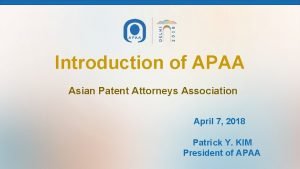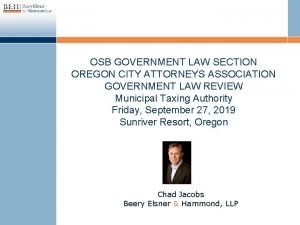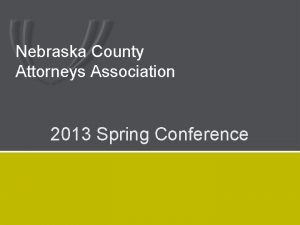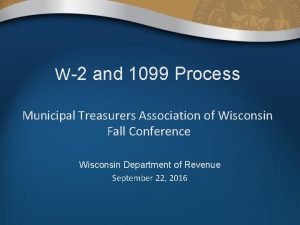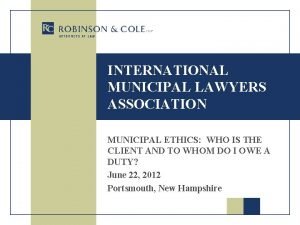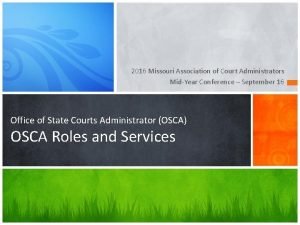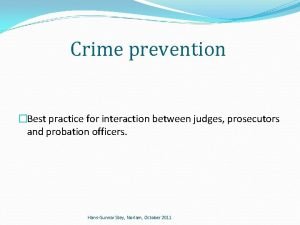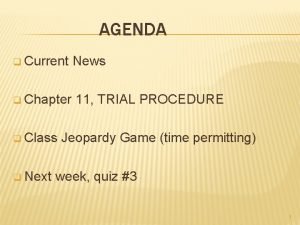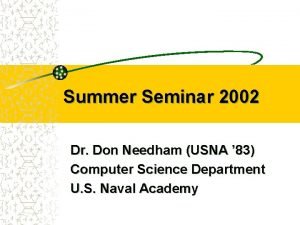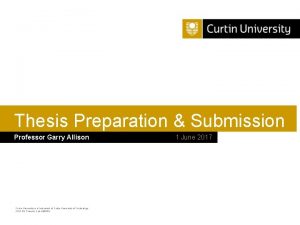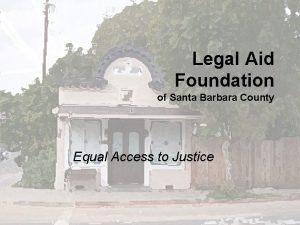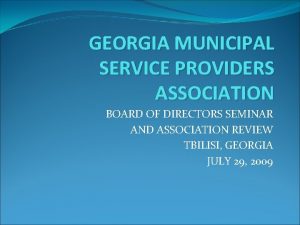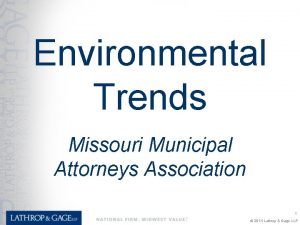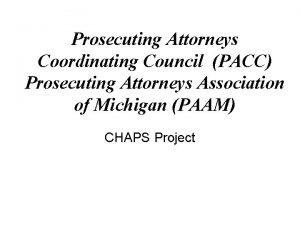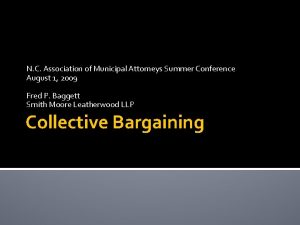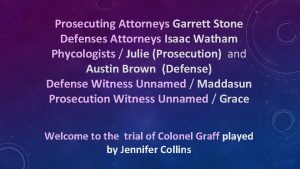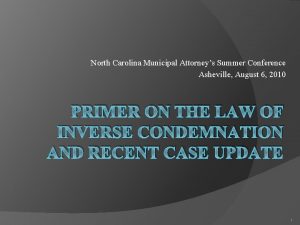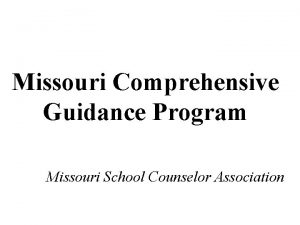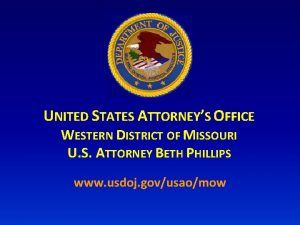MISSOURI MUNICIPAL ATTORNEYS ASSOCIATION SUMMER SEMINAR GARRY E





































- Slides: 37

MISSOURI MUNICIPAL ATTORNEYS ASSOCIATION SUMMER SEMINAR GARRY E. HUNTER, GENERAL COUNSEL OHIO MUNICIPAL LEAGUE/OHIO MUNICIPAL ATTORNEYS ASSOCIATION

§ Number of Drones and in particular Micro Drones has brought about a great amount of debate concerning legal statutes on the state and federal level. § Issues vary from voyeurism to midair collisions. § Logic would dictate specific and direct federal regulations and/or recommendations detailing the power of state laws to address local and regional issues. § Logic has not prevailed though as state legislators have been hamstrung by federal preemption. § FAA has laid out vague suggestions and is attempting to claim airspace from the ground up, including airspace previously considered private property. § Some states have enacted legislation under tort liability and Fourth Amendment precedents despite fear of federal preemption in order to protect citizens and set up policies regarding privacy and trespassing.

§ Areas where states can enact legislation with minimal fear of preemption: evidence § § § collection by law enforcement; weaponization of Drones; hunting; nuisance; and insurance requirements. History of Drones (Unmanned Aerial System) from 1909 is contained in paper. Until recently primarily used by military to deliver weapons and for surveillance. After September 11, 2001, Drones were used by military as predators to locate, tract, and fire missiles at terrorists. Since 2004, American Foundation has estimated that 420 drone attacks have killed 23, 000 militants and 275 to 360 civilians. Recent technology has produced miniature drones at inexpensive prices which has created the debate of violation of privacy vs the benefits of the increasing numbers of drones. FAA now claims that the U. S. airspace is from the ground up and flying drones below 400 feet, three miles from an airport violates FAA regulations. The term Drone includes UAV (unmanned aerial vehicle), UAS (unmanned aircraft system), and unmanned aircraft.

§ State waiting on federal regulation has not paid off. Federal government has failed to provide legislation concerning drones use outside of basic registration, federal airspace regulations, and weight limit restrictions, i. e. drones between. 55 and 55 pounds must be registered. § Common sense would assume the FAA would work in coordination with states, however, this is not the case. § FAA is calling into question state and local laws which prohibit activities such as flying drones over public gatherings, filming or capturing images of private activities, as well as First Amendment violations. § The battle between the FAA and state and local laws includes: flight altitude, operational bans within city limits, drone training, and other laws concerning safety and efficiency. § FAA does seem to allow local drone regulation concerning zoning, privacy, voyeurism and hunting.

§ Even though the FAA claims to preempt state and local law, the FAA interim regulations are lenient and non-specific. § It may be concluded that interests of multi-national corporation such as Google, and Amazon which wish to use Drones for commercial activities are given preference over state and local drone laws which would improve public safety, and clear up debates concerning privacy. § The failure of the FAA to grant states the independence to compose their individual drone statutes or provide specific federal guidelines for drone legislation has resulted in many conflicts throughout the country. For example in North Carolina, they have mandated that commercial operators of drones be tested and authorized via permit prior to legal drone operation. The state has had to be extremely careful not to interfere with the authority of the FAA in regards to airspace. In North Dakota, it is illegal to mount lethal weapons on drones. In Arkansas, drones may not capture film of specific buildings and power plants. In Michigan, it is illegal to use drones to hunt or to harass hunters.

§ A U. S. Senate Bill introduced in mid-March 2016 would grant the federal government preemptive control over drone laws including manufacturing, testing, licensing, registration, certification, operation and maintenance of drones. § Essentially, once again it is shown that the federal government wants to maintain that they own all air space and therefore can provide this space to multinational corporations (Amazon, Google, etc. ) for the use of drone delivery services. § The Aviation, Innovation, Reform, and Authorization Act (AAIR) under consideration by the US Senate would exempt from FAA regulations, Drones which are less than 4. 4 pounds and operated under 400 feet and at less than 46 mph while within the sight line of the operator in the daytime, while at least five miles from any airport. § A top drone lawyer in the US (Brendan Schulman) advocates this policy as he states that these drones may be no more danger to a plane than a bird. He states that these drones can be used to help local businesses and communities while empowering people. He insists that “A simple and accessible regulatory category will spur manufacturers to implement the best features into the smallest products that inherently pose the lowest risks. Incentivizing operators to use micro systems would immediately make the national airspace safer”.

§ Many people disagree with Mr. Schulman. § An important clause to make note of with the AAIR Act is a controversial change in regards to a proposal which would take the responsibility of air traffic control from the FAA and give it to a “newly established nonprofit corporation”. This would be a change in policy that would transfer this responsibility to a private company or companies. This has not been enacted yet, but it raises a number of questions which enhance the murkiness of the legislation which states have enacted with the threat of preemption hanging over their efforts. § In 2014, the FAA notes 214 drone sightings near airports, which increased to over 600 before the end of 2015. Between the months of Feb. 2014 -October 2015 there were 921 sightings of or near encounters with aircraft during this period of 21 months. 321 of these sightings were close encounters in which the pilot defined the encounter as a “near mid-air collision”. This is defined as “proximity hazard”, in which the drone came with 500 feet of the aircraft or the drone operator took “evasive action”. Twenty percent of the time the drone came within 50 feet according to the pilots, while 1 in 12 had to use evasive action or maneuver their plane to avoid colliding with the drone.

§ People and property are of course also greatly impacted by irresponsible drone operators. In July of 2015, a small UAS interfered with firefighters in California attempting to put out wildfires. As a result, the drone which was flying at 12, 000 feet came in close proximity to firefighting tankers, and caused one jettison to dump 2, 000 gallons of fire retardant. This caused firefighting aircraft to ground for 20 minutes and thus caused a delay, and contributed to the spreading of the wildfire. Various other reports of drones exist including crashing into stadium seating at major sporting events, and wreaking havoc on parachutists, as well as causing head injuries to an 11 month old girl at an outdoor movie theatre. Drones are also known to interfere with electrical lines and conductors. It is estimated that there will be 11 million small drones by 2020. § The FAA has failed to provide guidelines and restrictions which would limit this chaos. § The Interim Final Rule of Registration and Marketing Requirements for Small Unmanned Aircraft (2015) is an attempt to outline some of these requirements into a mandatory program, but it seems that their primary focus is attempting to ensure that they can identify the drone operator. The FAA has imposed a “No Drone Zone” program designed to keep UAS away from major sporting events, such as the super bowl, but fail to address the magnitude of drone issues. “Know Before You Fly” is another program to educated people and provides hobbyists with guidelines and restrictions, but this is voluntary.

§ A precedent was established 2014 that the FAA can fine operators of UAS’s for careless or reckless operation. § When it comes to general civilian discipline, the FAA typically sends warning notices which is a record that the transgression was noted but no fine or legal action will be taken. They can also send a letter of correction which requires action from the drone user and if they comply with the letter, they can avoid further punitive action. If they do not comply, they may face legal enforcement action. Both notices and letters can result in the UAS owner’s certificate of operation being suspended or revoked. In some cases, the drone user may face a fine and in rare cases may be referred to the Department of Justice. All of this makes no difference of course if the UAS operator has not registered their drone.

§ The FAA enforcement of UAS operation infractions are case specific. Ten factors are identified as options of enforcement and lists as such: § Nature of the violation § Whether the violation was inadvertent or deliberate § The certificate holder’s level of experience and responsibility § Attitude of the violator § The hazard to the safety of others which should have been foreseen § Action taken by the employer or other government authority § Length of time which had elapsed since violation § The certificate holder’s use of the certificate § The need for special deterrent action in a particular regulatory area or segment of the aviation community. § Presence of any factors involving national interest, such as the use of aircraft for criminal purposes.

§ The Administrative or enforcement action: § A first time, inadvertent violation that poses a low actual or potential risk to safety, but one in which the aviation safety inspector determines compliance cannot be gained through education warrants administration action (warning notices and letters of correction, with associated documentation). § When sufficient evidence exists to support a violation that poses a medium or high actual or potential risk to safety, legal enforcement action is appropriate. § Civil Penalties are applied in accordance with Order 2150. 3 B, Chapter 7 and appendix B: § A violation that poses a medium actual or potential risk to safety generally warrants a civil penalty in the minimum to moderate range. § A violation that poses a high actual or potential risk to safety generally warrants a civil penalty in the maximum range. § Repeated or intentional violations generally warrant a civil penalty in the applicable maximum range (FAA, 2015 a, p. H-10).

§ Many infractions are subject to criminal charges in regards to UAS operation according to the FAA. They are based primarily on circumstance and intent. This includes the act of threatening or touching a person with a UAS or the intent to cause bodily harm, and thus the drone operator can be charged with Aggravated Battery, and as it can be seen as a deadly weapon. § The major problem is that the FAA will not provide specific detail oriented legislation in regards to federal law, and thus the states must choose to enact state law or to wait on the FAA Id 14 -15. § In Florida for example, trespassing is an issue where the UAS operator can be charged if they enter, or hover another property without permission, invitation, or lawful authority to do so. This includes criminal voyeurism without knowledge and consent, taking into account reasonable expectation of privacy. Other states have reckless endangerment laws in which UAS operators can be charged if they put themselves or others in danger regardless of an actual injury occurring. This differs from an aggravated battery charge because the UAS operator does not have intent to cause harm due to negligence or recklessness. An analysis of 765 UAS encounter cases showed 66% are referred to state, local or federal law enforcement for review or other action.

§ Concerning civil liability, UAS operators can be subject to a variety of liability issues. § A major concern however, is the fact that many homeowners may not be covered if their homes are damaged by a UAS as there are clauses which may limit or exclude damage which may occur via “aircraft”. § Many provisional languages in homeowner insurance contracts exclude property or even injuries incurred via aircraft. § If homeowner contracts do not cover such damage, it follows that civil liability will be the only path by which the homeowner may seek to be compensated. In some cases, the mere fact that the UAS is being used for business at the time at which damage may have incurred invalidates a homeowners’ coverage. § In addition, there also intentional act clauses which may exclude the homeowner from coverage if the damage incurred happened accidentally on the part of the UAS operator.

§ If a UAS operator is a member of the Academy of Model Aeronautics there may be provided up to $2. 5 million dollars in insurance to cover liability in the case of bodily injury and property damage. § In order to meet the requirements of this coverage (which excludes injury or damage to the UAS operator’s family and property), the injury or damage must occur while operating within the safety guidelines of the academy. § The coverage is also null if the UAS is operated for business purposes. § The vast increase in the number of UAS’s in the U. S. took off in 2015. At this time, the FAA responded by creating the registry act, while in the process insisting that the FAA have preemption power of local and state governments. § Another response was to attack property rights by redefining federal airspace. § In 1926, the Supreme Court found that airspace 500 feet over a property holders land was indeed their property, this was a response to the fact that modern flight technically violated previous doctrines which maintained that the airspace above a property owner rights extended to the heavens. § In United States v. Causby, 328 U. S. 256 (1946), the Supreme Court declared that a property owner has rights to the “immediate reaches” of the enveloping atmosphere”, this was defined as “at least as much of the space above the ground as they can occupy or use in connection it in a physical sense” estimated at 83 feet.

§ The new FAA regulations violate these rights, while taking the power away from the property owner in regards to dealing with drones which may be in their immediate airspace. § One of the responses of the FAA in regards to the rise of small drones was to make it a felony to operate a small drone without registering a small drone under federal regulation (Section 336(a) of the 2012 FAA Modernization and Reform Act. This essentially would make every child whom received or played with a small toy a felon, revealing that the FAA is not serious about enforcing such laws. § The threat of preemption leaves communities often unable to protect their own citizens from localized drone issues. § Some communities have more UAS users than other, and thus should be able to properly address laws without the threat of preemption from the federal government.

§ Executive guidance via preemption “should not take actions limiting the policy making discretion of states unless…a problem of national significance requires “national activity”. § According to current federal guidelines, state and local legislations can impose rules and restrictions of airspace via enforcement of laws concerning fireworks and kites, but are unable to do so in the case of UAS’s. § It is the opinion of a large number of legal scholars that “laws traditionally related to state and local police power—including land use, zoning privacy, trespass and law enforcement operations generally are not subject to federal regulations” § The act of increasing federal airspace to ground level can be characterized as a land grab of private property which violates the ruling of the Supreme Court in the Causby case. This amounts to a massive seizure of property, as preemptive threats limit local and state government, it is plausible to assume that land owners have no rights in regards to privacy or defending their land from potentially dangerous UAS operators whom are not subject to non-existent federal laws such as operating drones while intoxicated or “drunk droning”.

§ The act of trespassing in a property owners airspace cannot be considered a transgression if the property owner does not own the airspace above their ground. This is another example of the countless violations of the law via the “hyperexpansion” of federal power. § The majority of states have yet to pass bills limiting, restricting, and defining the use of drones on commercial and recreational levels. As drone numbers increase across the country and worldwide, it has become commonplace to hear about dangerous, and sometimes near fatal examples of drone safety hazards. § In the case of commercial drones it was established by Congress via Wickard v. Filburn, 317 U. S. 111 (1942), that “Congress may use a relatively trivial impact on commerce as an excuse for broad general regulation of state or private activities. § However, there are other cases which are used to support the argument that federal agencies have limited power over drone activity in regards to the commercial drone industry. In order to enact federal legislation over drone activity, it must be demonstrated that there is a significant relationship and impact of interstate commerce.

§ The FAA has created Section 333 as an outlet to exempt specific drones based upon assessing UAS’s by specifying: § 1. Which types of unmanned aircraft systems, if any, as a result of their size, weight, speed, operational capability, proximity, to airports and populated areas, operation within visual line of site do not create hazard to users of the national airspace system or the public or pose a threat to national security; and § 2. Whether a certificate of waiver, certificate of authorization, or airworthiness certification under section 44704 of title 49, United States Code, is required for the operation of unmanned aircraft systems identified under paragraph (1). § (c) Requirements for Safe Operation. ---If the Secretary determines under this section that certain unmanned aircraft systems may operate safely in the national airspace system, the Secretary shall establish requirements for the safe operation of such aircraft systems in the national airspace system.

§ The vehicles which receive the most exemptions under Section 333 fall under the 20 pound weight limit. § To date, according the FAA website there have been 5, 361 petitions granted and 1, 692 petitions closed for exemptions under Section 333. § The hesitation to enact drone legislation on a state and local level is understandable if it is assumed that state and local governments did not want to take the time and money to do so out of fear that eventual federal legislation and the threat of preemption would render their efforts null and void. § In essence, the FAA is maintaining and expanding their power to maintain airspace based upon the assumption that UAS operation does not deviate from the traditional guidelines that the FAA should maintain airspace for planes, jets, and other aircraft which obviously fly at heights which rarely impact private property and citizen concerns.

§ The Supremacy Clause gives Congress the ability to override or preempt state law. § Technically the Supremacy Clause of the U. S. Constitution “nullifies state law that conflicts with federal law”. § These conflicts arise when “the United States Congress expressly forecloses state law in a statute (express preemption), when a state law or regulation directly conflicts with federal law (conflict preemption), or when the pervasiveness of federal regulation leaves no room for state regulation (field preemption)”. § A presumption against preemption does operate, but this typically does not apply in relation to aviation safety regulations. § This power can be implied, or it can be in the form of a statute which expressly preempts power.

§ The context in which implication is enforced comes in two forms: § field preemption in which Congress’s “intent is to displace state law altogether can be inferred from a framework of regulation so pervasive …that Congress left no room for states to supplement it, or where there is a federal interest…so dominate that federal system will be assumed to preclude enforcement of state laws on the same subject”. The second type of preemption is conflict preemption. This preemption includes “instances where the challenged state law stands as an obstacle to the accomplishment and execution of the full purposes and objectives of Congress”. § Conflict preemption mandates that “courts should assume that the historic police powers of the states are not superseded unless that was the clear and manifest purpose of Congress”. While “a statute purporting to delegate a power the Congress does not have is a legal nullity, so if a federal agency attempts to regulate an activity outside the Congress’s commerce power, the agency action is unconstitutional, just as a statue directly regulating the same activity would be”.

§ Local and state law in regards to regulating drone usage is unlikely to be done so via express preemption. The FAA only has one clause regarding express preemption concerning laws which are “related to a price, route, or service of an air carrier”. A federal court ruled that the preemption “does not restrict a local agency from determining the sitting of air fields”. In the case of privacy concerns related to UAS operation, the FAA has stated “state law and other legal protections for individual privacy may provide recourse for a person whose privacy may be affected through another person’s use of a UAS”. § The legal focus on preempting state and local power on UAS regulation typically comes via field preemption. This preemptive power allows the FAA to claim “complete and exclusive national sovereignty in the airspace of the United States”. This includes excluding local and state powers from enacting curfew regulations as it may limit FAA control over the control of traffic flow. The FAA via the Burbank Court has acknowledged that noise regulation can be enforced via local and state law as they retain the control over their airfields. Nevertheless the FAA’s administrator maintains that they must develop rules in order to regulate “the use of navigable airspace” as “necessary to ensure the safety of aircraft and the efficient use of airspace”. This includes adopting legislation and regulation concerning the flights of aircraft to protect people and aircraft via “navigable airspace efficiently” and well as “preventing collisions”.

§ One example of field preemption occurred via Arizona v U. S. , 132 S. Ct. 2492 (2012), in which the Arizona laws which imposed penalties more strict for alien regulation in regards to registration than U. S. federal government requirements. The issue at hand was the fact that the Arizona laws would according to federal officials would “frustrate federal policies”. In the case of UAS operation, it is clear that the FAA cannot effectively regulate on a national level, but this does not necessarily mean that they will continue to preempt state and local laws out of concern that they may continue to frustrate federal power and property grabs. § The states are technically allowed to control the ground on which a UAS takes off and land upon, but they are unable to control legislation regarding drone launches which occur outside of their jurisdiction. § The state and local governments which have imposed laws concerning drones in flight outside of these restrictions have done so with the knowledge that the FAA has the authority to govern policy “the use of this navigable airspace”, while regulating aircraft flight in the name of public protection while “using the navigable airspace efficiently”. § The navigable airspace is legally defined as “the airspace above the minimum altitudes of flight prescribed” by FAA regulations”. This includes FAA regulation of “including airspace needed to ensure safety in the takeoff and landing of aircraft”. The fact that the minimum aircraft altitude other than helicopters is 1000 feet or more, and leaves room for municipal regulations in regards to UAS operation in regards to privacy and other issues because they are not infringing upon the FAA control of safety.

§ Property owners according to the Supreme Court have “exclusive control of the immediate reaches of the enveloping atmosphere”. § It is also a fact that Congress has made no policy statement which would suggest that drones “can operate in the non-navigable airspace without interference”. § The fact that Congress chose to exempt non-commercial model aircraft from federal legislation, expressly limited federal regulation in regards to field exemption. The Reform Act of 2012 prohibits the FAA from making or enforcing new laws in regards to the regulation of non-commercial model aircraft. § In this regard, states and local governments are able to implement legislation in order to regulate model aircraft in order to provide some sense of control in the lack of federal legislation. § The fact that the FAA has left this space for state and local governments to navigate contradicts the assumption that preemption is pervasive. This specifically applies to privacy issues as state and local governments have regularly passed legislation in order to address these issues.

§ In the arena of conflict preemption, the FAA is unlikely to displace state and local regulations of UAS operation. § Conflict preemption dictates: “if the purpose of the act cannot otherwise be accomplished-if its operation within its chosen field will be frustrated and its provisions be refused their natural effect-the state law must yield to the regulation of Congress with the sphere of its designated power”. § Based upon this logic it can be assumed that local and state governments can regulate non-navigable airspaces in the time being. § In the case of private actions for trespass to land, it is recognized that the common law of trespassing may apply to “overflight close to the ground” as a violation. § This applies if an aircraft “enters into the immediate reaches of the air space next to the land it interferes substantially with the other’s use and enjoyment of his land”

§ With the increase in domestic UAVs it has become important for states to provide legislation which addresses key issues but also does not conflict with FAA regulations. § To reiterate FAA regulations, it is illegal to fly a UAV above 400 feet or out of the line of sight if the user (private or commercial) has not received approval from the FAA. § With the increase in the number of personal UAVs, tort liability and the right to privacy has become a key issue. § The issues are centered upon an individual’s right to own and fly a UAV in relation to other individual’s right to privacy in the form of trespassing and other forms of privacy invasion. § An individual’s home is typically viewed as the ultimate private property. § Drones which enter into the area of a particular home (including hovering in the vicinity) may be seen as nuisances and subject to a higher level of transgression in the context of privacy invasion.

§ It is important to note that Congress has failed to address privacy issues in regards to privacy and drone surveillance. In addition, the Federal Aviation Administration (FAA) did not include the issue of privacy provisions in their proposed rule on small drone aircrafts. The FAA has stated that its “mission does not include developing or enforcing policies pertaining to privacy or civil liberties”. § A major issue is the fact that the Supreme Court fails to recognize a violation of the Fourth Amendment in the “surveillance of private property while flying in navigable airspace”. § Surveillance when being used upon both the general population as well as targeted individuals via the use of UAVs begins with the collection of visual information with the use of camera sensors. § Many have questioned the right of government agencies or individuals drone operators to record or monitor our actions in public. § In the past, these questions most likely would have been thought to be extreme violations of privacy and condemned as contrary to many American values and rights to privacy. § In 1986, however, in the case of California v Ciraolo, 476 U. S. 207 (1986), it was ruled that “what a person knowingly exposes to the public, even in his own home or office, is not a subject of the Fourth Amendment protection. ” § In the case of Illinois v. Caballes, 543 U. S. 405 (2005), the Court found that the “expectation ‘that certain facts will not come about to the attention of the authorities is not the same as interest in ‘privacy that society is prepared to consider reasonable”.

§ It has been recommended that in order to regulate UASs, that 10 principles be followed: § Agree upon a concept of operations for UAV flights in civil airspace; § Develop a classification scheme and definitions for UAVs as they related to operation in civil airspace; § Establish regulations for UAV system certification, flight operations, and ground controller qualifications; § Develop effective technologies and procedures to prevent collisions of the ground, or other obstacles; UAVs with other aircraft, § Institute security controls and approvals for UAV operations; § Develop and implement communications solutions for UAV systems; § Develop an aeronautical data exchange, processing and synchronization network that accounts for unique UAV requirements; § Internationally harmonize UAV regulations, certification standards, and operational procedures; § Ensure interoperability with the air traffic system and assess potential impacts on the air traffic system and its regulatory and operational environment; § Gain public acceptance and actively communicate with all potentially affected parties.

State Legislation Enacted Florida Bill Date Approved Date Effective Paraphrase C. S. S. S. B 766 5 -14 -15 Freedom from Unwarranted Surveillance Act Prohibits law enforcement use to gather evidence. Prohibits recording an image of privately owned property or of the owner (tenant, occupant, invitee etc. ) violating a reasonable expectation of privacy. Exceptions: police get warrant, “perform reasonable tasks” within the scope of one’s license, property appraisals, utility inspection, mapping, delivery cargo (as long as with FAA compliance) Idaho IC 21 -213 No law enforcement searches without a warrant. No aerial photography without prior consent. Illinois 720 Ill. Comp. Stat 5/48 -3 Freedom from Drone Surveillance Act Prohibits law enforcement use of drones without a warrant. No drone interference with hunters. Indiana IC 35 -33 -5 -9 7 -1 -14 No law enforcement use without a warrant.

Iowa HF 2289 5 -23 -14 Maryland SB 370 5 -12 -15 Mississippi SB 2022 4 -23 -15 Montana HB 330 4 -23 -15 Nevada AB 236 The largest and most comprehensive bill No drones for traffic law enforcement. Evidence obtained with a drone without a search warrant is inadmissible. 7 -1 -15 Only the state can make drone laws (preempts counties and local ordinances). Define felonious trespass to include peeping through a window, hole or opening with a drone. Prohibits photographs and video of people without consent. 10 -1 -15 No weaponized or armored drones for law enforcement. No person shall weaponize a drone or operate a weaponized drone. No operation within 500 ft. or 250 ft. vertically from a “critical facility” and 5 miles from airport with consent. Right of action (trespass) if drone less than 250 ft. over property and property owner notifies DROP that the flight is unauthorized. No use for law enforcement to collect evidence. Creates a public registry of all state operated drones.

New Hampshire SB 222 5 -7 -15 Fish and Game—Animal-Harassment 1 -1 -16 No activity that disturbs animals with intent to prevent their lawful taking. No drone use with intent to conduct video surveillance of citizen lawfully hunting, fishing or trapping, without prior consent. North Dakota HB 1328 4 -15 -15 Evidence obtained by a drone not admissible as evidence without a search warrant nor can law enforcement use drone footage as a basis for probable cause. No lethal weapons on a drone. Does not prohibit drone usage for research and development by edu. inst. Oregon HB 2534 Fish and Game— Fish and Wildlife 5 -12 -15 Prohibit the use of drones related to pursuit of wildlife (angling, hunting, and trapping) or aiding through use of drones to harass, track, locate, or scout wildlife; and interfere with angling, hunting and trapping. The definition of drone includes unmanned water-based vehicles. Commission—Drone and Regulation HB 2354: only definition of drone changed to “unmanned aircraft system”

Tennessee 4 -20 -15 Texas HB 153 Crimes and Offenses—Drones— Photography and Pictures 423. 008 Utah HB 296 3 -27 -15 West Virginia HB 2515 Wildlife— Animals--Weapons WSA 941. 292 4 -2 -15 No operation over events with 100+ attendees for a ticketed event; no flight around fireworks without event organizers consent Law enforcement must submit a report of drone use to the governor. Evidence obtained by a drone not admissible as evidence without a search warrant. Prohibits hunting with drone 4 -10 -14 No weaponized drones. Wisconsin WSA 175. 55 7 -1 -15 No law enforcement use without warrant.

§ Of the states which have passed (or attempted to pass) bills concerning drone regulations, only Virginia and North Carolina have failed to pass bills which would require warrants in order to prevent law enforcement abuse of drone activities. § In regards to law enforcement and drone statutes, Constitutional limitations apply to unreasonable search and seizure. § Without a search warrant states should be unable to gather evidence without a genuine search warrant. Illinois for example, is not able to “use a drone to gather information “unless it obtains a search warrant prior to the search”. § Only crime scene and traffic investigation situations are able to use drones in specific circumstances. § States such as Wisconsin, Indiana, and Illinois are unable to use drones to gather evidence without a search warrant. If these statutes are violated, the results of the investigation are null and void. Probable cause in North Dakota has prohibited the use of drone evidence as a case to establish probable cause as a tool to establish a search warrant via captured evidence.

§ In addition to requiring search warrants for law enforcement to collect evidence some states have enacted legislations that strictly prohibits law enforcement from weaponizing drones. § Wisconsin provides language that does not allows for equipping a drone with armor while others extend these prohibitions to civilian drone operations as well. § In order to maintain the safety of the public, currently 17 states have legal framework or bills which ban the weaponization of drones. § In the area of civil remedies, there are twenty states which now have legislation allowing offended parties to pursue civil action when aggrieved. § There have been many statutes enacted by states that handle the issue of privacy. For example, Florida, “prohibits any surveillance of a privately owned property, its owner and anyone legally occupying the premise (landlord, tenant, or licensee). ”In Idaho, it is illegal to film/photograph an individual via drone with the consent of the owner or occupant. It is reasonable to suggest that in some cases, that capturing images of a property would be appropriate and some cases have legitimated drone use in these cases, (property appraisals, utility inspections, and mapping).

§ Conclusion § The majority of states have proposed legislation in the hope of enacting drone laws in the future as they navigate FAA regulations and gauge the possibilities of preemption. § The fact that the FAA has, to a large degree, failed to address the legal issues which have arose with the massive increase of drones, while strong-arming state governments with a federal preemption argument, is a clear sign the federal government may be deliberately preventing, and/or, stalling adequate drone legislation. § If we take into consideration the fact that the use of commercial drones is in its infancy, there is a possible correlation with the massive grab of airspace which the FAA has undertaken.

§ It is widely acknowledged that corporate interests generally have great effects and impacts upon federal legislation. § It is a possibility that the FAA is delaying adequate legislation in order to gauge the future needs of the commercial drone market. § If so, it would be a logical deduction to conclude that the corporate interests, and the demand for airspace in a rapidly developing market, may have been given priority over developing common sense drone legislation. § The use of preemption, and other methods, to minimize state power is a clear sign that the FAA is attempting to maintain control of drone laws at the cost of logical and cohesive state legislative action. § As a result, states are forced to look for gray areas in which they can potentially enact legislation. Some states have tabled potential legislation out of fear of preemption, and at the cost of potential social benefits that could be achieved via a clear and precise set of rules and regulations which could be based upon the needs of the state, or region, in need of such legislation.

Garry E. Hunter General Counsel Ohio Municipal Attorneys Association Ohio Municipal League 175 S. Third Street, Suite 510 Columbus, Ohio 43215 614. 221. 4349 ghunter@omlohio. org
 Asian patent attorneys association
Asian patent attorneys association Oregon city attorneys association
Oregon city attorneys association Nebraska county attorney association
Nebraska county attorney association Louisiana municipal association
Louisiana municipal association Wisconsin municipal treasurers association
Wisconsin municipal treasurers association Kentucky municipal utilities association
Kentucky municipal utilities association International municipal lawyers association
International municipal lawyers association Missouri school counselor association
Missouri school counselor association Missouri primary care association
Missouri primary care association Missouri association of court administrators
Missouri association of court administrators Missouri recycling association
Missouri recycling association Norlam attorneys
Norlam attorneys Lhl attorneys
Lhl attorneys Khurana & khurana advocates and ip attorneys (delhi branch)
Khurana & khurana advocates and ip attorneys (delhi branch) Deepwater horizon oil spill
Deepwater horizon oil spill Khurana & khurana advocates and ip attorneys
Khurana & khurana advocates and ip attorneys O.j. simpson prosecuting attorneys
O.j. simpson prosecuting attorneys Berne convention
Berne convention Fulbright hays summer seminar
Fulbright hays summer seminar Word pad
Word pad Garry berryman
Garry berryman Garry allison
Garry allison Garry meadows
Garry meadows Legal aid foundation santa barbara
Legal aid foundation santa barbara Garry charnock
Garry charnock Garry singh iiris
Garry singh iiris Garry tew
Garry tew Patharapong bhuripanyo
Patharapong bhuripanyo Garry meadows
Garry meadows Access fort garry
Access fort garry Garry jacobs
Garry jacobs Garry i
Garry i Garry
Garry Garry puetz
Garry puetz Municipal service providers
Municipal service providers Organigrama de presidencia municipal - san josé iturbide
Organigrama de presidencia municipal - san josé iturbide Organigrama de un presidente municipal
Organigrama de un presidente municipal Pme campo grande ms
Pme campo grande ms
